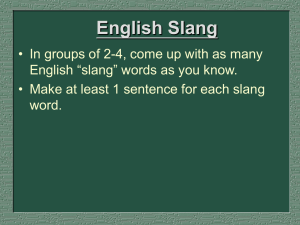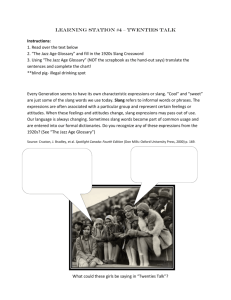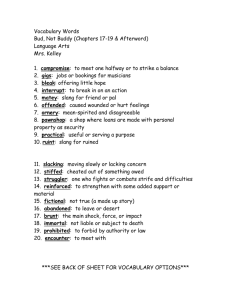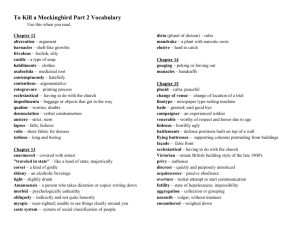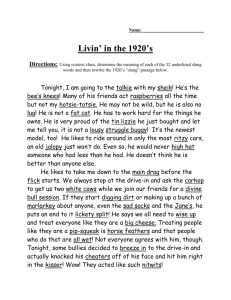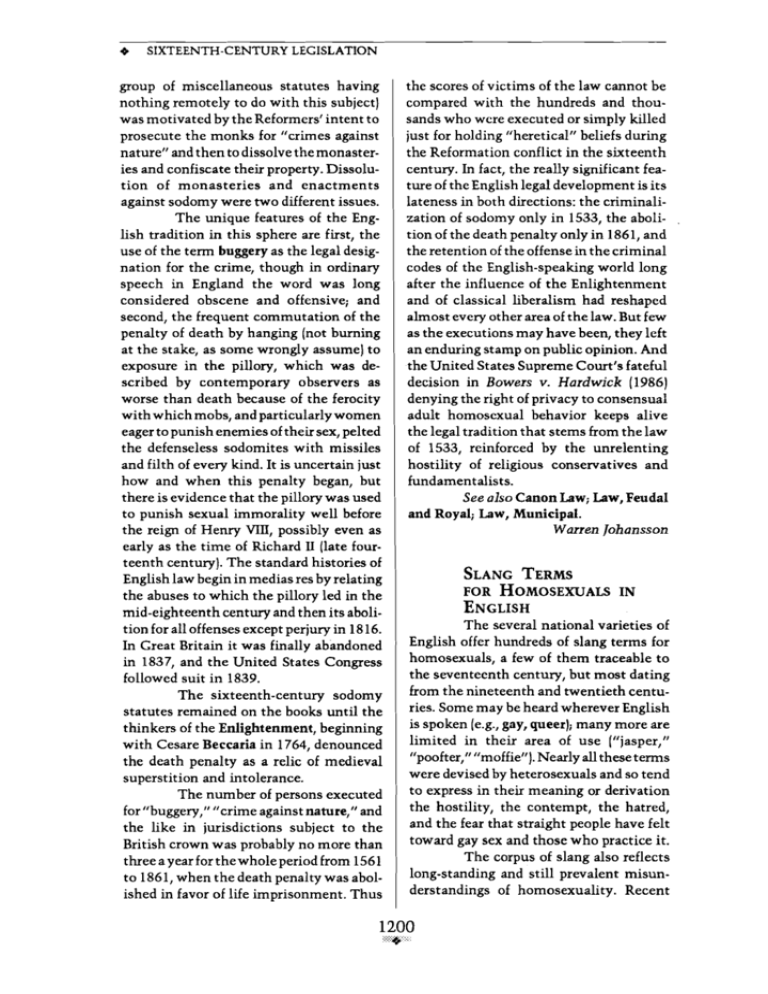
4
SIXTEENTH-CENTURYLEGISLATION
group of miscellaneous statutes having
nothing remotely to do with this subject)
was motivated by theReformersl intent to
prosecute the monks for "crimes against
nature" and then to dissolve the monasteries and confiscate their property. Dissolution of monasteries and enactments
against sodomy were two different issues.
The unique features of the English tradition in this sphere are first, the
use of the term buggery as the legal designation for the crime, though in ordinary
speech in England the word was long
considered obscene and offensive; and
second, the frequent commutation of the
penalty of death by hanging (not burning
at the stake, as some wrongly assume) to
exposure in the pillory, which was described by contemporary observers as
worse than death because of the ferocity
with which mobs, and particularly women
eager to punish enemies of their sex, pelted
the defenseless sodomites with missiles
and filth of every kind. It is uncertain just
how and when this penalty began, but
there is evidence that the pillory was used
to punish sexual immorality well before
the reign of Henry VIII, possibly even as
early as the time of Richard U (late fourteenth century). The standard histories of
English law begin in medias res by relating
the abuses to which the pillory led in the
mid-eighteenth century and then its abolition for all offenses except perjury in 1816.
In Great Britain it was finally abandoned
in 1837, and the United States Congress
followed suit in 1839.
The sixteenth-century sodomy
statutes remained on the books until the
thinkers of the Enlightenment, beginning
with Cesare Beccaria in 1764, denounced
the death penalty as a relic of medieval
superstition and intolerance.
The number of persons executed
for "buggery," "crime against nature," and
the like in jurisdictions subject to the
British crown was probably no more than
three a yearforthewhole period from 1561
to 1861, when the death penalty was abolished in favor of life imprisonment. Thus
the scores of victims of the law cannot be
compared with the hundreds and thousands who were executed or simply killed
just for holding "heretical" beliefs during
the Reformation conflict in the sixteenth
century. In fact, the really significant feature of the English legal development is its
lateness in both directions: the criminalization of sodomy only in 1533, the abolition of the death penalty only in 1861, and
the retention of the offense in the criminal
codes of the English-speaking world long
after the influence of the Enlightenment
and of classical liberalism had reshaped
almost every other area of the law. But few
as the executions may have been, they left
an enduring stamp on public opinion. And
the United States Supreme Court's fateful
decision in Bowers v. Hardwick (1986)
denying the right of privacy to consensual
adult homosexual behavior keeps alive
the legal tradition that stems from the law
of 1533, reinforced by the unrelenting
hostility of religious conservatives and
fundamentalists.
See also Canon Law; Law, Feudal
and Royal; Law, Municipal.
Warren Johansson
SLANGTERMS
HOMOSEXUALS
IN
ENGLISH
FOR
The several national varieties of
English offer hundreds of slang terms for
homosexuals, a few of them traceable to
the seventeenth century, but most dating
from the nineteenth and twentieth centuries. Some may be heard wherever English
is spoken (e.g., gay, queer); many more are
limited in their area of use ("jasper,"
"poofter," "moffie"). Nearly all these terms
were devised by heterosexuals and so tend
to express in their meaning or derivation
the hostility, the contempt, the hatred,
and the fear that straight people have felt
toward gay sex and those who practice it.
The corpus of slang also reflects
long-standing and still prevalent misunderstandings of homosexuality. Recent
SLANG
exposures of and challenges to these misconceptions have made as yet little impression on the language, and although
individuals may have modified their usage, offensive, misconceived, and otherwise objectionable terms continue to be
used.
Gay people have themselves
adopted many of these terms, becauseuntil
recently their understanding of themselves
and their sexuality differed little from the
views of the society in which they lived.
Basic Categories. Almost all
terms for male homosexuals fall into four
simple categories: first, those taking or
assumed to take the "active," masculine
role, the insertor role, in anal intercourse;
secondly, the "passive," feminine role, the
receptor role, in anal intercourse; thirdly,
effeminate men who may be gay (there is
some overlap between the latter two
categories). Finally, for United States
English, a category of fellator (cocksucker
engaged in oral activity) is needed.
A similar typonymy, without a
fourth category corresponding to fellator,
applies to terms for lesbians. First, masculine, "active"; secondly, (ultra-)feminine,
"passive"; and, thirdly, mannish women
who may be lesbian. Again, there is some
overlap between the first and third categories. Even though early sexology distinguished cunnilinctrixes from tribades,
calling the former "sapphists" and "Lesbian lovers" (this original sense became
obscured when these terms became generic for female homosexuals), English
slang does not seem to have developed
similar categories. There are many slang
terms for those who perform oral sex on
women ("cuntlapper," "-licker";
"muffdiver," "plater"; "gamahucher,"
ilgamah~cker,""gamarucker," and so
forth) but none is specifically homosexual in application.
These categories mirror the traditional equation of biological sex and gender role, whereby male anatomy entails
masculinity and female anatomy femininity. From this psychobiological determin-
9
ism flow crude popular notions of male
and female sexuality generally and an
erroneous conception of homosexuality
that has not yet been completely dispelled. It is the belief that for a man to
renounce the "active," definitively male
role of penile penetration and submit to
the "passive," female role of accepting the
intromission of a penis, he must be a
female, either psychically or both mentally and behaviorally.
Slang embodying this simple active vs. passive categorization according
to roles in sexual activity can be found
reduplicated again and again, in different
English-speaking countries, in different
periods, and in specific close knit or exclusive groups. In particular, whenever men
are kept in isolation from women, it is
likely that asystem of slang corresponding
to this pattern will arise. Examples of such
masculine worlds in which situational
homosexuality occurs are prisons, navies
(and other armed forces to a lesser extent),
boarding schools, among seafarers and hoboes. Even today there are relatively few
slang terms that do not assign or imply a
role in sexualactivity, and these-"queer,"
"homo," "poof(ter)," "les," "lez," "lezzie," "gayu-have usually become general
only recently. A few other words are
sometimes neutral w h e n used by
homosexuals: fag(got),queen, dyke.
Male Terms. By far the largest
number of male slang terms fall into the
categories of male passivity and effeminacy, which imply the renunciation of
one's maleness. By contrast, the active
insertor terms seldom imply femininity or
the loss of masculinity. Very often they
refer expressly to taking the active role in
anal intercourse: "arse-king," "arselassbandit," "arse-burglar," "booty-bandit,"
"bud sallogh" (Irish, "shitten prick," obsolete), "backdoor('sj man," "gentleman of
the backdoor," "backgammoner," "inspector of manholes," "dirt-trackrider," "turdpacker," "dung-pusher," "poo-jabber." The
Australian prison slang for the active partner "hock" has the same implication, for it
"morphodite," "morphydite," "morphrois rhyming slang on "cock." One of the
equivalent American terms, "jocker," is
dite," and in South Africa "moffie." It has
also yielded "freak."
likewise probably derived from "jock,"
One of the most prolific sources
which means "fuck" as a verb and "cock"
as a noun. In the case of the synonym
of femininewords has beenmalepmstitu"wolf" the association is the same but
tion. Evidence of this phenomenon inLonmetaphoric rather than direct.
don exists from the Middle Ages, and late
The key to understanding a large
nineteenth-centurywriters on homosexuality such as Havelock Ellis and "Xavier
number of passive/effeminate terms is the
supposed reversal of gender and sex roles:
Mayne" (E. I. Prime-Stevenson)state that
it was widespread throughout Europe and
the adoption of behavior deemed "natuthe United States. The prostitution took
ral" or appropriate to the opposite sex. A
two main forms. Highly masculine men,
man who is passive must in some sense be
especially soldiers, who were poorly paid,
a woman; even one who is raped is judged
made themselves available as "active"
to have "lost his manhood" and becomes
partners. The older tradition involved very
de facto a woman. Many slang terms for
effeminate men, often cross-dressers,who
the passive homosexual directly personify
him as avagina or an anus: "gash," "pussy,"
frequented certain taverns or bars; some"gentleman pussy," "sea-pussy," "boytimes their activity was outright arsepussy," "boy-snatch," "b~y-cunt,"~~bum- peddling, but often it seems to have been
sex in return for a good time paid for by the
boy," 'lpoonce" (from Yiddish for "cunt" J,
masculine male. In the seventeenth and
"brownie-queen,""browning-sister" or"queen," "mustard-pot," "jere."
eighteenth centuries such effeminate men
Another common procedure is to
were called mollies (from "Moll," the petapply a word that has female reference.
form of Mary, which meant "harlot" or
The most direct method is to use a female
"hussy") and the places where they opername. The oldest known slang term
ated were molly-houses.
"Molly" is an example, and "Marjery,"
The semantic transition from
"Mary-Ann," and "Charlotte-Ann" are
"harlot" and/or "slatternly woman, hussy"
further obsolete instances. Other nineto "effeminate passive homosexual" and
teenth-century examples still survive:
hence "homosexual" generally is the
source of some of the most common terms
"Miss Nancy," "Nance," "Pansy" (and
forhomosexuals. Such words include fairy,
other flowers),"Mary," "Betty," "Dinah,"
"Ethyl," "Nola" have been recorded in the
"nancy" or "nance," "queenlquean," and,
United States and in Australia the (obsocontrary to popular myth, "fag" and "faglete?)"Gussie" (from Augusta]. Or it may
got." Above all there is the term "gay"
be any one of the large number of words
itself, which in its present sense has not
normally used of females: "aunt(ie],"
been traced earlier than the 1920s but
"chicken," "fem(me]," "girl," "bitch,"
which clearly derives from the earlier
"belle," "mother," "queen," "sis(sieJ,"
slang sense of "sexually dissolute, promisllsister,'l l'wife," and the like. Or it may be
cuous, libertine," a sense often applied to
female prostitutes. Other less familiar
a word that refers to stereotypically feminine behavior: 'llimp-wrist," "brokenexamples of this shift include "aunt(ie)"
wrist," "flit," "mince," "prissy," "swish."
(originally meaning "brothel-keeper, old
(See Women's Names for Male Homoprostitute"), "ginch," "hump," "kife,"
sexuals.)
"twidget," and "skippy."
Another way of seeing male
The long tradition of male prostihomosexuals as women is to view them as
tution in London has meant that workinghermaphrodites. This confusion has seen
class Londoners have had a long exposure
the word "hermaphrodite" corrupted into
to it. London slang, particularly Cockney
SLANG
rhyming slang, is very rich in terms for
effeminate homosexuals, many of which
live on in Australian slang. One nineteenth-century term was "sod," which
survives as a mild term of abuse, its original sense largely forgotten. It in turn gave
rise to the rhyming slang "Tommy Dodd,"
shortened to "Tommy." More important
is "poofi' ("pouf"), attested from 1833,
which has yielded the elaborated Australian form "poofter" (now spread to New
Zealand andBritain1and therhymingslang
"horse's hoof" or "horses" (Australian
variant, "cow's hoof") and "iron hoof" or
"iron." The variant form "puff," attested
from 1902, may have originally been only
a spelling variant rather than representing
a different pronunciation; however that
may be, it has spawned "collar and cuff" or
"cuff" and "nigh enough" or "enuff."
"Queer" has yielded "Brighton Pier,"
"ginger beer," shortened to "ginger," "King
Lear," and, some have argued, "jere" and
"gear." In Australian English "queen" has
given rise to "pork and bean" and (poor
example) "submarine."
United States English is rich in
terms for homosexual fellators. Other
varieties of English have no such slang,
although associated terms such as "blowjob" and "head" (neither necessarily
homosexual)have recently begun to penetrate other Englishes. The earliest written
record of the word "cock-sucker" occurs
in John S. Farmer and W. E. Henley's Slang
andits Analogues, vol. 2 (1891),and interestingly they define it as "fellatrix." In the
United States, however, the word applies
to a homosexual, is one of the most taboo
of words, and is also one of the strongest
terms of abuse. The American homosexual's predilection for fellatio is longestablished, for already in 1915 Havelock
Ellis recorded the slang term "headworker." Later synonyms include "blowboy,'' "flute(r)," "cannibal," "gobbler,"
"larro" (back-slang),"mouser," "muzzler,"
"dick-sucker," "dick(ie)-licker," "skindiver," "nibbler," "lapper," "lick-box."
9
Lesbianism. Terms for lesbians
are far less common than those for homosexual men, a fact that is consonant with
the greater invisibility of the lesbian inthe
past. No term now current can be traced
earlier than the 1920s. In the eighteenth
century lesbian practices were referred to
as "the game of flats," but there was apparently no tcrm for the practitioners. In the
late ninetcenth century two spinsters livingtogetherwerereferred to, in partsof the
United States, as being in a Boston marriage. The phenomenon of "tomboyishness" was widely recognized and far less
deprecated than the male equivalent "sisslhood," yct it was not commonly or usually associated with lesbianism.
The word lesbian itself has given
rise to many shortenings: "les(s)," "lessie,"
"lez," "lezzie," "lezzo," "lesbie" and the
associated pun "lesbie-friends," "lesbo,"
"lesley"; and the jocular elaboration "lesbyterian." All of these are generic. Most
other terms fall into the butch-fem/"fluff"
categories and most seem to be of United
States origin.
The oldest term seems to be "bulldyke(r)" or "bull-dyking woman." The
latterwas alsoshortened to "B.D. woman."
These terms first appear in black circles in
the 1920s, and "bull-dyking" and "B.D."
occur in the blues. The most plausible
etymology of the "-dykeu element, which
later became an independent word with
the same sense, is that it derives from the
late nineteenth-century slang "dike"
meaning "to dress up formally or elegantly." This derivation would suggest
the priority of "bull-dyker" over "bulldyke," which accords with the evidence.
There are also corrupt forms "bull-dagger"
and "boon-dagger," and "bull" too has
become an independent word. "Dyke" has
spread to other English-speaking countries, and is often reinforced with the
word "diesel."
Other masculine-lesbian terms
include "butch," "amy-john" (from
"amazon"), "jasper," "stud," "baby-stud,"
"tootsie."
9
SLANG
The feminine, "passive" lesbian
is a "fem(me]," "fluff," "fairy-lover," and
"lady-lover." This last is used generically.
Conclusion. Language and particularly slang mirrors salient facts about
the society in which it is used, and this is
true of all the slang names for homosexuals that have accumulated over the past
two centuries. They show in their meaning and derivation the popular understandings of homosexuals and homosexual
behavior and sexual activity. That the
understanding and perceptions involved
are so frequently wrong makes the task of
overcoming prejudice and ill-will so much
harder, for the detritus remains embedded
in the language. It is no accident that
English has so few slang terms that mean
homosexual, pure and simple, without
reference to sexual roles and acts.
Studies of the slang vocabularies
of other Western European languageshave
shown that they are as rich as English. In
all modern languages, apparently, money,
inebriation, and sex are all especially productive of popular terms. However, homosexualvocabularies are highly insular: even
SpanishandPortuguese, so similar in other
ways, show hardly any commonality in
their slang terms for gay men and lesbians.
Nonetheless, the whole group of Western
languages displays some common semantic elements: gender reversal (imputation
of effeminacy to gay men and masculinity
to lesbians); use of women's names as
generic terms for male homosexuals; inheritance of medieval Christian words of
the "bugger" and"sodomiteUfamilies; and
adaptations of psychiatric and medical
terms. Occasionally slang terms migrate
from one language to another, as French
tante to German (alsovariant: Tunte], and
(probably) in loan-translation form to
English as aunt(ie). In recent years the
English word "gay" has entered these
languages, and others as well.
BIBLIOGRAPHY. Wayne R. Dynes,
Homolexis: A Historical and Cultural
Lexicon of Homosexuality, New York:
Gay Academic Union, 1985; Gershon
Legman, "The Language of Homosexuality: An American Glossary," in Gwrge
W. Henry, Sex Variants, New York: P . B.
Hoeber, 1941; Guild Dictionary of
Homosexual Terms, Washington, D.C.:
Guild Press, 1965; Bruce Rodgers, The
Queens' Vernacular, San Francisco:
Straight Arrow Books, 1972.
G. S. Simes
SLAVERY
1
1
1
The institution of slavery, under
which one human being was the property
of another and his labor power could be
exploited by the owner with no remuneration beyond bare subsistence, existedfrom
the dawn of history down to modern times.
In some countries of the New World the
agriculturalsector abandoned slavery only
in the second half of the nineteenth century. Most studies of slavery have concentrated on the economic aspect, fewer on
the social and political. Only a very few
have entered into the sexual exploitation
that slavery entailed, and these tended to
focus on the problems of marriage and
childbearing rather than on the homosexual side.
General Considerations. The
person of the slave belonged to the master,
and could be used for sexual gratification
as well as for economic gain. The slave
could not in most cases refuse the master's
advances, whether theywere heterosexual
or homosexual. The inferior status of the
slave translated into the passive role in
homosexual intercourse, which was always assigned to the party of 1owerrank.In
ancient city-states the free citizen was
forbidden to prostitute himself without
loss of status, so that the profession of
prostitute could beexercised only by slaves
or foreigners and sometimes by freedmen.
For this reason handsome young males
captured in battle or in slavehuntingraids
were likely to find their way into brothels,
a fate preferable to the hard labor imposed
on slaves in the mines and latifundia of the
magnates and great landowners. It was no
disgrace for the slave to be subordinated
sexually to the master, but simply part of




